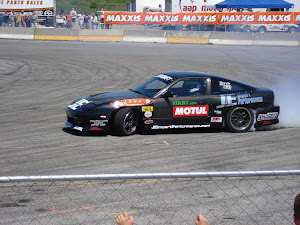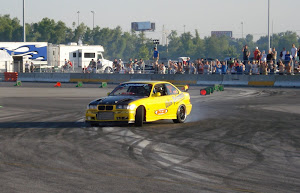There are 7 identified techniques to performing a drift. These 7 are arguable, but I'm going to list these 7 as I know them.
E-Brake Drift
Probably the easiest way to initiate a drift. Drive into the corner and pull the emergency brake, follow up by feathering the throttle around the corner. Easy huh? Well maybe easier said than done. Most amateurs start out using this technique but soon become more apt to other techniques. More veteran drifters still use the E-brake technique but for merely prolonging drifts and increasing drift angle.
Power Over
This technique is used by more heavily powered cars but can be used by others as well. Power over is when you make your turn like normal but are more aggressive with the throttle and inducing a sort of burn out while turning, causing the rear end to break free and kick out. Feathering the throttle at this point will maintain your drift through the corner.
Feint
Ever swerved your vehicle too hard and noticed that your rear end wants to keep sliding out? Well that is the basic principle of the feint. As you approach your turn you make an interesting decision... To turn the opposite way, then back again. This will cause your rear tires to break free. Continue on as others feathering the throttle.
Trail Brake Drift
As you come to a corner, you notice you are going a little fast? Well this is the prerequisite for trail braking. You brake hard, shifting the weight of the car to the front wheels and following up by turning into the corner causing the rear wheels to break free.
Clutch Kick
While approaching a turn, the driver keeps the throttle pressed down. Once you are at the curve you quickly depress and release the clutch causing rpms to jump. This will cause the tires to break free. Veteran drivers use this technique to increase drift angle and prolong drift like the e-brake drift.
Shift Lock
The driver downshifts while keeping the clutch depressed. Once at the point of entry for the corner, the driver lets off of the clutch creating tension on the transmission components and causing loss of traction of the drive axle.
Kansai Drift
One of the more difficult forms. It's performed similar to the trail braking technique. The main difference in Kansai is the fact you don't use the brake. Accelerate into the corner and as you left off the accelerator it causes the weight to transfer to the front axle causing traction loss in the rear axle. Drift away!
Although this is a slop job of explaining, these are the basics. The key is to practice and learn all.
(...on a closed course. I do not take any responsibility for your actions, especially if performed on public roads, parking lots, or land.) Support your local drift parks!!
)r!F+ a\/\/aY
240sx at NOPI

Monday, December 3, 2007
Friday, November 30, 2007
First of Many
This is my first attempt at the blogging scene so I will try and do my best! This page will be a full out dedication to my love and passion; DRIFTING! Drifting is the act of controlled oversteer in an automobile, or for that matter anthing with wheels. Oversteer is when you turn your car through a corner and the rear tires would like to continue going forwards as your front tires follow the arc of the corner. The opposite of oversteer is called understeer. Understeer is when your car's front wheels want to continue going forwards while in turn and your rear tires follow suit. Drifting is the latest craze of automotive competition and has been my passion for many years. I started drifting my 100cc atv when I was 10 years old and have continued to love it ever since.
I will try to convey many ideas, techniques, skill, forms, cars, websites, drifters, sponsers, locations, and many other aspects of the sport in my coming blogs. So stay tuned young, or old, drifters!
driftitdsway
I will try to convey many ideas, techniques, skill, forms, cars, websites, drifters, sponsers, locations, and many other aspects of the sport in my coming blogs. So stay tuned young, or old, drifters!
driftitdsway
Subscribe to:
Posts (Atom)

